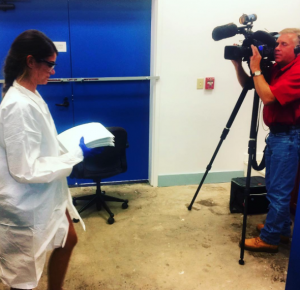
Not only did Karli serve as the Lead Swim Guide Intern, she also conducted sampling for Cahaba Riverkeeper! Rain or Shine!
My name is Karli; I am the Lead Swim Guide Intern at Coosa Riverkeeper. I am a rising senior at Berry College majoring in Environmental Science with a concentration in Chemistry. A majority of my internship has been spent in the lab processing the samples that are collected through our Swim Guide program or our monitoring efforts. So far this summer, I have been responsible for over 1,000 samples. Since I do the same thing over and over again, my lab time consists of listening to a lot of pod casts and jamming to Hamilton. Often, I find myself getting caught up in the monotony, but when I talk about the process of what is actually happening I get excited again!! So warning, this blog post will be tailored to my fellow nerds.
In our lab we are testing for the bacteria, E. coli. It is important that the sample that is collected is representative of the sample that is processed in the lab. One would think that this is an easy task, but data on bacteria can change from the time that the sample is collected to the time it is processed if you are not careful! There are four things that a bacterium needs to grow: time, food, water and warmth.
All of these conditions are how we set our foundations on how our samples are collected and processed. A few things that we do to make sure our data is top notch are keeping our coolers between 0-10 degrees Celsius, taking duplicates at 10% of our sites, setting a six hour time limit on sample collecting, using sodium thiosulfate to dechlorinate the sample water (chlorine kills bacteria), and using a field blank to make sure there was no contamination in the cooler.
When the samples are taken to the lab, the first thing I do is check that the cooler was less than 10 degrees Celsius. After the temperature blank reads less than 10, I put all of the samples into a hot water bath to heat them back up to room temperature. Once they have reached about 25 degrees Celsius, I put all of my fancy lab gear on (includes a paper lab coat, safety goggles and gloves AKA my favorite outfit) and then I bring them over to the lab bench to be processed.
The thing about testing for bacteria is that you cannot do it with out a little help from…AN ENZYME! We use an enzyme called Colilert-18 that allows the concurrent detection of total coliforms and E. coli. The substrates that are present in the Colilert react with the total coliform to turn yellow, and with an enzyme found in E. coli to turn fluorescent when under a UV light, after an incubation period of 18 hours at 35 degrees Celsius.
The amount of wells in the tray that are yellow indicate a positive reaction for total coliform while the fluorescent wells indicate a positive reaction for E. coli. By counting the amount of wells that had a positive reaction for E. coli, we are able to estimate very accurately the colony-forming unit per 100 mL of sample water.
Science is the coolest.





